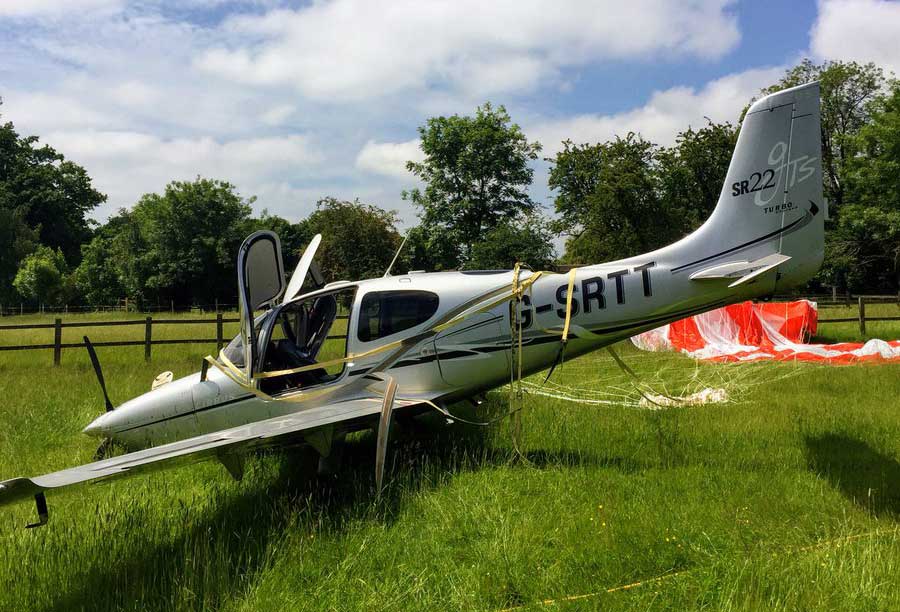+VIDEO Two people suffered minor injuries after their Cirrus SR22 aircraft deployed its parachute recovery system for a forced-landing in a field in Hertfordshire at the weekend.
Pilot Jonathan Cobb told BBC News that the aircraft’s engine failed. He deployed the Cirrus Airframe Parachute System (CAPS) at about 1,200ft agl. It appears to be a textbook ‘save’ by the parachute system.
“What I can see is the ground rushing up on me. We descended to the ground, it was pretty hairy,” said Cobb. “The most incredible thing is that – and we are pinching ourselves about it – we were not hurt at all, given the crash.”
BBC News has this video:
Local police and other emergency services were quickly on the scene.
The aircraft parachute works by pulling a red CAPS handle on the ceiling inside the cockpit. This deploys a solid-fuel rocket out of a hatch covering the parachute’s store behind the cabin. As the rocket carries the parachute rearward from the back of the airplane, harness straps embedded into the fuselage are released. Within seconds, the 65ft diameter canopy unfolds, controlling the aircraft’s rate of descent. The final landing is absorbed by specialised landing gear, a roll cage and energy absorbing seats.













9 comments
Skilled piloting? Open fields, perfect weather, 1200′ yet he chose to wreck the plane.
I’ve had to make forced landings three times over the last fourty years and, 3.5 thousand hours. One was from only 900ft. No damage to aircraft or persons. Perhaps I was lucky but, kept calm and found it no big deal.
Comments condemning Cirrus parachute use like this in public forums can contribute to people making bad decisions and may cost lives.
Both survived unscathed, and the moment they pulled the parachute that was almost certain. Those odds evaporate in an off-field landing in aircraft like an SR22.
Once the engine fails the aircraft belongs to the insurer and a skilled pilot will take the safest path.
Bravo to the pilot for putting his and his passenger’s safety above all else.
First: no injuries = good landing.
I agree that a current pilot should be able to land safely in daylight after an engine failure over non-hostile terrain in a suitable aircraft, although force landing a Cirrus in a field may not end as well as in the case of some GA aircraft.
In this case there were no injuries, which is great. But maybe that is not so much an endorsement of CAPS per se, but a question mark over the restrictions of the design of the aeroplane, which I think is reflected in insurance and maintenance costs. It is all down to choice and I do not mean putting cost over safety.
I am an Australian Cirrus pilot and all I would say is that it appears given the circumstances, the pilot made the correct decision.
I know what I would do in the circumstances, BG, and I’ve had engine failures in my 60 year career.
And the aircraft wasn’t “wrecked”.
The technology is there. Use it.
Part of the Cirrus transition training is to deploy the chute under such circumstances. It provides a much better chance of survival than trying to make a forced landing, perhaps hitting a hole and flipping the aircraft.
The aircraft wasn’t wrecked but who cares if it was , they walked away and that’s all that matters.
Why is there always some “superior skilled pilot” ready to disparage another rather, than praise a decision that ensured two people are still walk Ng and talking?
Just wonder how many pilots deploy the system at engine failure. When in normal training and PFL ‘s aircraft without system have to do a false landing. Supose decision is pic a field and pull the chord or pick a field and try land nirmally. I supose the chord parachute gives less chance of damage ?
I fly both PA-28 and SR-20. Cirrus definitely advises to use the CAPS above 500 ft whatever happens, as the chances of survival are MUCH higher. Even the picture above shows that the landing could’ve been tricky (properties rather than fields, hence fences, trees, maybe cattle, houses, children…). So YES he made the good decision and if I were in the same circumstances, unless I have a runway under my wings, I’ll use the parachute (despite of the fact with Piper PA-28 I’ve been trained to cope with engine failures and imagine forced landings just in case).